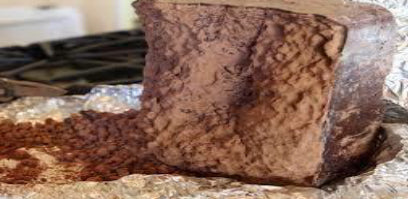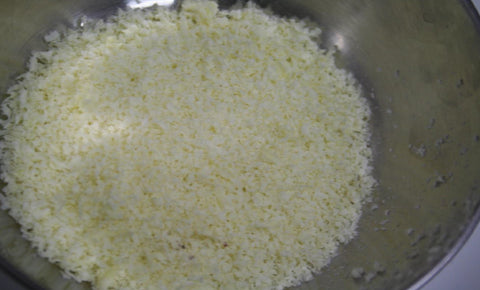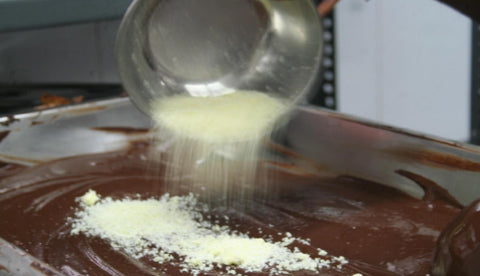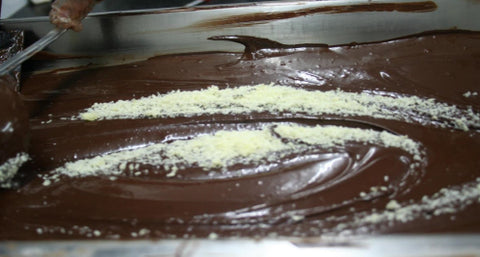
Chocolate Tempering
Introduction
Tempering is explained in detail here. Chocolate operations cannot be done without tempering first. If you are in a hurry or don’t want to spend too much time reading, please go to the last paragraph, which gives easy steps for tempering
Tempering in a Nutshell
Chocolate contains cocoa butter as fat. Milk and white chocolates contain some quantity of milk fat also. Cocoa butter has six polymorphous forms numbered one to six. Two of these forms are stable. Others are either unstable or semi stable. These continue to change form till a stable form is reached. These changes make the chocolate crumbly and patchy, negatively affecting its mouth feel and appearance.
Tempering makes the chocolate set in one of the two stable forms we choose, avoiding patchiness and crumbliness, giving it great mouth feel and appearance.

Photo I: Untempered Chocolate

Photo II: Tempered Chocolate Bar
Chocolate vs Compound
The main difference between chocolate and compound is that chocolate has only cocoa butter as fat (except in the cases of milk and white chocolates where some milk fat is also present), while compound has only hydrogenated vegetable oils as fat. Since fat in compound is not polymorphous it does not require tempering. It can be melted and used directly.
Polymorphous forms of Cocoa Butter
I have mentioned earlier that coco butter is polymorphous and that is the reason why Chocolate needs tempering. The table below lists the polymorphous forms of cocoa butter.
| Polymorph | Melting Point (degrees) | Remarks |
| I | 17.3 | Unstable |
| II | 23.3 | Unstable |
| III | 25.5 | Semi-stable |
| IV | 27.3 | Semi-stable |
| V | 33.8 | Stable |
| VI | 36.3 | Stable |
As can be seen from the table above, cocoa butter has six polymorphous forms. These are crystalline forms of sold cocoa butter. It does not exist in liquid cocoa butter. One and two are called unstable, while forms three and four are called semi stable. Five and six forms are called stable. The unstable and semi stable crystals change forms to the next higher form. One becomes two, two becomes Three, three becomes four and four becomes five. Five is a stable form and it remains there for at least one year. This change from 1 to 5 make the chocolate crumbly and patchy.
Another aspect to be noted is that each polymorphous form has a different melting point.
Photo three. Untempered chocolate
In Photo 1, the patchiness is caused by change of polymorphous forms. To avoid this unpleasant appearance, and poor mouth feel caused by the crumbliness, we need to ensure that on cooling melted cocoa butter should form solid crystals of only of only either one of the two stable forms only, say V. Preparing cocoa butter or chocolate for this is called tempering or pre crystallisation.
A special quality of Cocoa Butter
Cocoa butter has a special quality. If melted cocoa butter has adequate quantity of cocoa butter crystals of one of the two stable forms well distributed, when cooled, all solid crystals formed will be of that form. Eg, if the melted cocoa butter contains solid crystals of form V, when cooled the entire cocoa butter will form into V. Tempering is made possible because of this property of cocoa butter.
Classical Method of Tempering
This is also called table top tempering. Chocolate is melted in a kettle. It is then poured on a stone surface table top, keeping about a third. Chocolate on the table top is worked with a spatula. Chocolate temperature drops and Beta V crystals form. The chocolatier feels the firmness on his spatula, slight hardening or a slight increase in viscosity. This formation of Beta V crystals should give sufficient temper, except that when Beta V is actually formed some IV is also formed which is undesirable. Beta IV is removed by adding a little hot chocolate from the kettle. The chocolatier continues to work the spatula and performing moulding or dipping. After a while more crystals will be formed and the chocolate will become firmer. He now adds some more hot chocolate to melt out some of the crystals and continues his work.
This method of tempering require a lot of judgement and experience. Errors are common requiring repetition of the process. There is another method of tempering. In this the temp of the melted chocolate is brought down to about 27^C. Beta V crystals are formed at this temp. Along with the Beta V some Betaa IV crystals will also be formed. This unwanted Beta IV crystals are melted out by taking the temp up to 31.5 and 30.5*c for dark and milk respectively. Temp for milk is applicable or white also. Chocolate now has adequate quantity of Beta V crystals and is therefor tempered.
New Method: Tempering by Seeding
This is the method that is most commonly used for tempering. The chocolate is first melted completely free of all solid forms and then seed which is powdered or grated cocoa butter in Beta V form is added after cooling to about the melting point of Beta V. The chocolate is now tempered.
You can buy seed from us or make at home. Freshly melted cocoa butter if cooled changes itself completely to Beta V in about 15 days. This can be grated and used as seed. Tempered chocolate can also be used as seed after grating. If you use chocolate you need to use three times the weight of cocoa butter that you would use. This is because couverture contains cocoa butter about one third by weight.
While grating, care should be taken to ensure that the seed does not melt by the heat generated while grating. Grater should be frozen. The butter or chocolate should also be frozen before grating.
Easy steps for Tempering
- Melt the chocolate to be tempered, In a water bath or microwave oven.
- Go upto 45*C.
- Take off the water bath or microwave and cool to 34*C for dark chocolate and 33*C for milk and white chocolates.
- Sprinkle cocoa butter Beta V powder or tempered chocolate powder. The quantity required is 5gm per Kg of melted chocolate if using cocoa butter or 15gm per kg if using tempered chocolate powder.
- Stir well for 5 to 10 mins. The chocolate is now tempered.
- If required to stay at temper for extended periods of time, maintain temp of 31.5*C for dark and 30.5*C for milk and white chocolates. At these temperatures temper is stable.

Photo III (above): Melted chocolate temperature movement carried out

Photo IV (above): Grated cocoa butter in form Beta V for used unseed

Photo V (above): Sprinkling seed on chocolate

Photo IV (above): Stirring nicely for 5 to 10mins

Photo VII (above): Chocolate is now tempered


